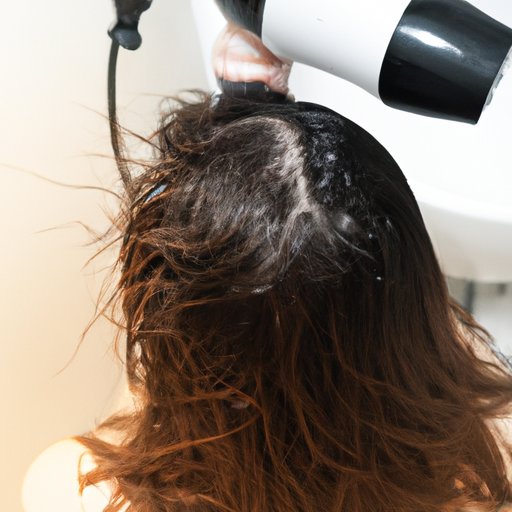Introduction
Damp hair, the in-between stage of wet and dry hair, can be a challenge to manage. This article provides a comprehensive guide to damp hair, including the science behind it, different styling options, and tips for maintaining healthy hair. Whether you air-dry your hair or blow-dry it, this article has got you covered.

Understanding the Science Behind Damp Hair: How It Happens and What You Can Do About It
Have you ever wondered why your hair becomes so damp after washing it? Water makes hair swell, which causes the cuticles to lift. This results in hair feeling and looking frizzy. In addition to washing, factors such as humidity can also contribute to damp hair.
To prevent damp hair, you can try rinsing your hair with cooler water, using a microfiber towel, or using a protective serum to lock in moisture and prevent frizz.
The Benefits of Drying Your Hair to Dampness: A Guide to Air-Drying Techniques
Drying your hair to dampness might seem like an inconvenience, but it has several benefits. By air-drying, you avoid heat damage, which can cause split ends and dryness. Additionally, air-drying is more environmentally friendly than using heat styling tools.
If you want to try air-drying your hair, start by using a wide-tooth comb to remove tangles. Then, squeeze out excess water before using a leave-in conditioner or oil. Next, use a diffuser to distribute the product evenly before leaving your hair to dry naturally.
The Perfect Blowout: Techniques to Achieving a Professional-Grade Blowout on Damp Hair
Blow-drying damp hair is a common and effective method for achieving a professional-grade blowout. By applying heat to your hair, you can give it more shape and volume. However, it’s essential to use the right technique to avoid heat damage.
To achieve a perfect blowout, start by applying a heat protectant spray to your damp hair. Then, section your hair into 1-2 inch pieces and blow-dry each section using a round brush. Finally, finish with a cool down to set the style and add shine.
Damp Hair Styling 101: Steps to Creating Any Look You Want, From Beachy Waves to Structured Updos
There are plenty of hairstyles that work well with damp hair. With the right styling products and techniques, you can create any look you want. Beachy waves, structured updos, and braids are all easy to style with damp hair.
To create beachy waves, use a salt spray on your damp hair before twisting sections around your finger. For structured updos, use a styling cream and pins to create a sleek look. Finally, braids can be created by twisting damp hair and pinning it in a bun or using a French braid technique.
What to Do When You Can’t Decide Between Dry or Damp Hair: Pros and Cons of Both Styling Methods
Deciding whether to style your hair when it’s damp or dry can be tricky. There are pros and cons to each method depending on your hair type and what style you want to achieve.
When styling damp hair, you can create more volume and hold than dry styling. However, it can take longer to style and might not work for all hair types. With dry styling, you can create a sleeker look quickly and easily. However, heat styling tools can cause damage and dryness.
Expert Tips for Maintaining Hair Health While Dealing With Dampness: The Dos and Don’ts of Hair Drying
To maintain hair health while dealing with dampness, follow some simple dos and don’ts of hair drying. Dos include using a microfiber towel or cotton t-shirt to dry your hair and using a heat protectant spray when styling with heat tools. Don’ts include using a hairdryer on high heat and using hot oil treatments too frequently.
Additionally, be mindful of the products you use on your hair. Avoid products that contain alcohol, silicones, and sulfates, as they can dry out your hair and cause damage.
How to Tell the Difference Between Damp and Wet Hair and Why It Matters for Your Hair Health
Knowing the difference between damp and wet hair matters for your hair health. Wet hair is typically saturated with water and can be easily damaged and prone to breakage. In contrast, damp hair has some moisture but is not fully saturated, making it more manageable and less prone to damage.
To properly dry wet hair, avoid rubbing it with a towel and minimize the use of heat styling tools. Instead, use a wide-tooth comb or brush to remove tangles and air-dry as much as possible before applying any styling products.
Conclusion
In conclusion, damp hair can be challenging to manage, but with the right techniques and products, it’s possible to achieve professional-looking styles while maintaining healthy hair. Whether you choose to air-dry or blow-dry your hair, be mindful of the dos and don’ts of hair drying and avoid damaging products. By following the tips provided in this article, you can feel confident in your hair styling skills and keep your hair looking and feeling its best.


